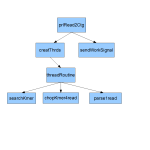![SOAPdenovo2 Demystified – part (b) [multi-thread implementations]](https://images.unsplash.com/photo-1516192426739-c4455b0a2fae?ixlib=rb-1.2.1&ixid=eyJhcHBfaWQiOjEyMDd9&auto=format&fit=crop&w=750&q=80)
SOAPdenovo2 Demystified – part (b) [multi-thread implementations]
We apologize for not being able to post our remaining SOAPdenovo2-related commentaries. So far, we presented a general overview of SOAPdenovo2, and also looked at library functions and their associated algorithms. Today, we will go through files, whose names start with prl (prlHashCtg.c, prlHashReads.c, prlRead2Ctg.c, prlRead2path.c, prlReadFillGap.c) and check their threading-related functions. Two additional files - cutTipPreGraph.c and read2edge.c - also implemented multi-threading codes and will be covered in this discussion.
Multi-threading is a method of allowing multiple cores in the processor to be used to perform parallel execution of codes. Implementing multi-threaded code needs two steps -
(i) to modify codes so that threading-related lines are implemented. That is the easy step,
(ii) to figure out or change the algorithm so that all threads are independent and do not result in any race conditions. That is the hard step.
-——————————
(i)
Let us discuss the easy part first. All mentioned files have the following functions -
1. static void threadRoutine ( void * para )
2. static void creatThrds ( pthread_t * threads, PARAMETER * paras )
3. static void thread_wait ( pthread_t * threads )
4. static void sendWorkSignal ( unsigned char SIG, unsigned char *
thrdSignals )
Together, they manage the parallelization. The whole process is not at all complicated, and you will have to work through one example step by step and then simply use some template code and fill up the blocks.
If you are not at all familiar with multi-threading, here is a good introduction to the terms. Here, instead of describing sample codes, we will go inside SOAPdenovo2 files and explain how they parallelize by working through an example.
We will look into prlRead2Ctg.c file. For the time being, let us forget about what it does, although you can guess that from the file-name. The file has functions to map the reads to the contigs.
The function createThrds usually has the following generic syntax.
`
static void creatThrds ( pthread_t * threads, PARAMETER * paras )
{
unsigned char i;
int temp;
for ( i = 0; i < thrd_num; i++ )
{
if ( ( temp = pthread_create ( &threads;[i], NULL, ( void * ) threadRoutine, & ( paras[i] ) ) ) != 0 )
{
fprintf ( stderr, “Create threads failed.\n” );
exit ( 1 );
}
}
fprintf ( stderr, “%d thread(s) initialized.\n”, thrd_num );
}`
The function creates number of threads, and calls **threadRoutine **for each one.
The function **sendWorkSignal **also usually has very generic syntax.
`
static void sendWorkSignal ( unsigned char SIG, unsigned char * thrdSignals )
{
int t;
for ( t = 0; t < thrd_num; t++ )
{
thrdSignals[t + 1] = SIG;
}
while ( 1 )
{
usleep ( 10 );
for ( t = 0; t < thrd_num; t++ )
if ( thrdSignals[t + 1] )
{
break;
}
if ( t == thrd_num )
{
break;
}
}
}
`
Real heavy lifting gets done by the function threadRoutine. It calls functions for execution of individual threads.
In the bigger scheme, the main function of the file prlRead2Ctg calls both creatThrds and sendWorkSignal, and then creatThrds calls all little functions. It is that simple !!

-——————————–
(ii) If the above part appears simple, you are wrong. The real hard part is in understanding the algorithm and splitting the code into independent threadable units.
Think about a computer algorithm+code as a bowl of noodles like this one.

When you multi-thread, each thread needs to look like this -

Untangling the pieces of noodles is the main challenge. The task is less complex, when we map thousands of reads on the contigs. Mapping of each read is an independent problem, whose result is unaffected by mapping of another read. That is why most multi-threaded files in SOAPdenovo2 are mapping- related.
We will add more about following seven files, and update their wiki pages in the coming days.
NameMain functionSingle functionsPurpose
prlHashCtg.c
prlContig2nodes
singleKmer, chopKmer4read
Chops contigs into k-mers
prlHashReads.c
prlRead2HashTable
singleKmer, chopKmer4read, thread_mark, thread_delow
prlRead2Ctg.c
prlRead2Ctg
parse1read, searchKmer, chopKmer4read
prlRead2path.c
prlRead2edge
searchKmer, chopKmer4read, parse1read, search1kmerPlus, thread_add1preArc,
prlReadFillGap.c
prlReadsCloseGap
emptyDarray, check1scaf
cutTipPreGraph.c
Mark1in1outNode
thread_mark
read2edge.c
Read2edge, Read2edge2
chopKmer4read, searchKmer1read